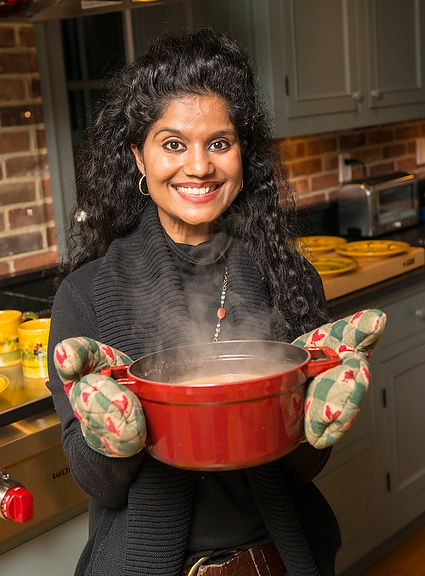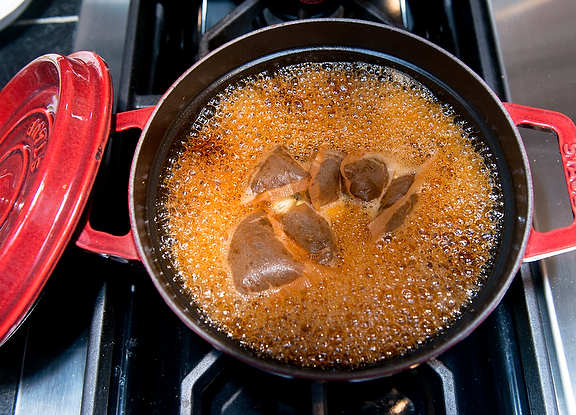If you’ve ever had the pleasure of brewing a strong cup of chai the entire process is as therapeutic as drinking the exotic beverage!
My morning ritual begins with the hottest water in an oversized mug. (Bigger is always better.) I adore watching those black tea leaves get christened with the scalding water slowly staining my porcelain cup with its mahogany goodness. Embracing the mug in both hands, I take long deep breaths as the blend of crushed spices disperse among the black tea leaves and permeate one another. As the heat warms my hands and the steam hits my face I can almost picture a Mumbai chai-wallah (a street vendor who makes chai for a living) pouring the strong brew from one glass to another like a silting Himalayan waterfall. I get lost in the aromatic fog. The whiffs of chai give my sleepy face a cardamom facial while the chai cools down. On quiet mornings when I’m not hurrying out the door, making a cup of chai also brings back memories of my childhood in the city of Mumbai.
Although chai has gained tremendous popularity in the West there is some confusion as to what chai is and how to refer to this spicy beverage.
Chai is traditionally a hot beverage made with Assam or Nilgiri black tea leaves heavily infused with a variety of spices: cinnamon, cardamom, clove, star-anise, fennel, peppercorns, and ginger brewed in a blend of hot water and milk with added sweetener to one’s taste and preference. In Hindi, chai means “tea.” So if you ask for a cup of chai-tea, you are literally asking for a cup of tea-tea. You might get a confused look from your chai-wallah.
In the southern part of India, masala chai is ubiquitous. “Masala” in Hindi means spices. So if you ask for a masala chai expect a potent version of chai: black tea brewed and blended with a powdered version of the spices. Masala chai is primarily made with whole milk, no water, in an attempt to mellow and balance out the robust spicy flavors.
Recently, in a bout of nostalgia, on a frigid day in January, I made an entire crockpot of chai. I threw in a box of black tea bags into some hot water and left the heavy mulling ball bursting with cardamom pods, nutmeg, peppercorns, chunks of raw ginger, crushed cinnamon sticks and bits of clove. The ball sat there happily steeping in the dark brew for three days enhancing it with its Ayurvedic goodness. Just one good chug and it made my heart gallop like a Morgan Horse! Even I had to admit it needed a generous splash of cream.
Back in Mumbai, chai was an intrinsic part of our daily lives, no matter how hot it got! One of my fondest memories as a young girl was surprising my dad with a perfect cup of tea as he got home from work. Barely old enough to stand by a stove, I would open the stainless steel can filled with Nilgiri tea leaves and dig right in to get an oversized heap. Gently, I’d add in the raw milk that was hand delivered promptly at 5a.m. Occasionally, a little bit of heavy cream would slide in…ah, creamy perfection! I knew dad loved that extra treat. I watched impatiently as it came to a boil. I would then throw in the tiniest stick of cinnamon, a couple of cardamom pods, cloves, peppercorns, and if I felt adventurous a big knob of ginger.
I could always time my father and knew exactly what time he would walk in the door with his newspaper in hand. He was punctual to a fault and routine was his middle name. I didn’t need to ask him how his day went because with a cup of chai in his hand I knew life was good! His shoulders would relax as he took in his first whiff of his evening chai after a long day at work. I could sense the tension of his day melt away as he took his first slurp. It was always too hot to sip. Dad chose to slurp it instead.
I can’t even talk about chai without reminiscing about our evening family-tea time back in Mumbai. Marie and Parle-G biscuits were a staple to go along with our tea. If we were out of our stash, I was charged with 5 rupees in hand to walk to the convenience store at the end of our street and pick up biscuits to go along with our chai. Now, I can’t walk past the ethnic aisle at our local grocery store without picking up at least a couple of packs of those golden-wrapped Marie biscuits. I’ve gotten my daughter hooked on them, too. She won’t ask for them every day, but on days when she needs some special mommy time she knows to come up to me and ask for chai and biscuits. She even dunks the biscuits into her chai the way I did. We sit quietly at the kitchen table and share a pack. Sometimes she over dunks and a few chunks fall in and she scoops them out. She might not know how to make chai from scratch or realize how trendy it has become these days, but she does know that with mommy by her side, chai and her favorite biscuits in hand, life is good! And so the chai drinking family tradition continues.
All photos: Ted Axelrod Photography, of course!
- Chai for two
- 16 oz (2 cups) Whole Milk or water
- 6 *black tea bags or 12-13 grams of tea leaves.
- 4 Cloves
- 1 long stick of cinnamon
- 2 thick slices, knobs or grated ginger
- 2 green cardamom pods, slightly crushed
- 4 black peppercorns
- 4 teaspoons of raw sugar
- On a low flame, heat the milk or water until it’s almost to a boiling point, throw in the tea bags and all the spices and bring down to a stern simmer for 5 minutes.
- Keep the flame low at all times until end. Slowly bring to a boil again, when the milk rises to the top, turn it off. Strain in a colander or pull out spice ball.
- If you chose water as your base either drink it straight up with sugar, or add in a generous splash of Half ‘n Half or light cream at the end to cut the strong chai.
- *Assam, Kenyan, Nilgiri, Ceylon black tea eaves provide the strongest black tea blend. Try to avoid a Darjeeling blend – totally different flavor, English Breakfast Twinning (too acidic) Earl Grey (too weak).
- You can use Agave Nectar as a substitute. Agave is 1.5 x sweeter than sugar, so I use only 1 & a 1/2 teaspoons of Agave per 8 oz. of milk.

